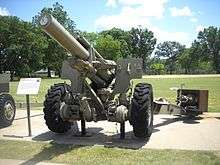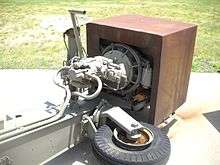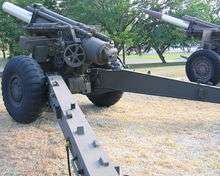M114 155 mm howitzer
| M114 155 mm Howitzer | |
|---|---|
 | |
| Type | Howitzer |
| Place of origin | United States |
| Service history | |
| In service | 1942–present |
| Used by | See operators |
| Wars | World War II, Korean War, Vietnam War, Lebanese Civil War |
| Production history | |
| Designed | 1939–1941 |
| Manufacturer | Rock Island Arsenal (US) |
| Produced | 1941–1953 |
| Number built | 10,300+ |
| Variants | none |
| Specifications | |
| Weight |
Travel: 5,800 kg (12,800 lb) Combat: 5,600 kg (12,300 lb) |
| Length | Travel: 7.315 m (20 ft) |
| Barrel length |
Bore: 3.564 m (11 ft 8 in) L/23 Overall: 3.79 m (12 ft 5 in) L/24.5 |
| Width | Travel: 2.438 m (8 ft) |
| Height | Travel: 1.8 m (5 ft 11 in) |
| Crew | 11 |
|
| |
| Shell | separate-loading bagged charge |
| Caliber | 155 mm (6.1 in) |
| Breech | slow-cone interrupted screw |
| Recoil | hydropneumatic system |
| Carriage | split trail |
| Elevation | -2°/+63° |
| Traverse | 25° left or right |
| Rate of fire |
burst: 4 rpm sustained: 40 rph |
| Muzzle velocity | 563 m/s (1,847 ft/s) |
| Maximum firing range | 14,600 m (16,000 yd) |
The M114 155 mm howitzer was a towed howitzer developed and used by the United States Army. It was first produced in 1942 as a medium artillery piece under the designation of 155 mm Howitzer M1. It saw service with the US Army during World War II, the Korean War, and the Vietnam War, before being replaced by the M198 howitzer.
The gun was also used by the armed forces of many nations, including Afghanistan, Argentina, Austria, Belgium, Brazil, Bosnia, Cambodia, Cameroon, Canada, Chile, Republic of China, Croatia, Denmark, Germany, Ecuador, France, Greece, Iran, Iraq, Israel, Italy, Japan, Jordan, South Vietnam, South Korea, Lebanon, Libya, Norway, Netherlands, Pakistan, the Philippines, Portugal, Saudi Arabia, Singapore, Spain, Thailand, Turkey, Venezuela, Vietnam and Yugoslavia.
In some countries, the M114 still remains in service.
Development
A new carriage was under development for much of the 1930s for the existing World War I-era M-1918 155 mm howitzer, which was a license-built French Canon de 155 C modèle 1917 Schneider until 1939 when it was realized that it did not seem logical to put a new carriage underneath an obsolete howitzer. So development began anew with a carriage designed to be used for either the 155 mm howitzer or the 4.7-inch (120 mm) gun. This was completed by 15 May 1941 when the Howitzer M1 on the Carriage M1 was standardized. The howitzer itself differed from the older model by a lengthened barrel of 20 calibers and a new breech mechanism. Uniquely it was the sole 'slow-cone' interrupted screw mechanism to enter service after 1920.[1] This meant that two separate movements were necessary to open the breech, versus the single movement of the 'steep cone' mechanism that simultaneously rotated and withdrew the breech.
The M1A1 was redesignated as the M114A1 in 1962.
Carriage variants
The carriage was also used by the 4.5 inch Gun M-1. It went through a number of minor changes over time. The original Warner electric brakes were replaced by Westinghouse air brakes on the M1A1. Both the M1 and M1A1 carriages used a mid-axle firing pedestal that was extended by a ratchet mechanism. The M1A2 replaced the ratchet with a screw-jack system and also modified the traveling lock. The M1A1E1 carriage was intended for use in jungle and muddy terrain and replaced the wheels of the M1A1 with a free-wheeling tracked suspension, but the project was terminated after V-J day without having reached production. The T-9 and T-10 carriages were projects using low-grade steel alloys that were canceled when no longer needed. The T-16 was a light-weight carriage using high-grade steel that was estimated to save some 1,200 lb (540 kg); work began in July 1945 and continued after the war, although nothing seems to have come from it.[1]
A mid-1960s variant was the 155mm XM123 & M123A1 auxiliary-propelled howitzers. The XM123 was produced by American Machine and Foundry and outfitted with two 20 horsepower air-cooled engines produced by Consolidated Diesel Corporation, driver’s seat, steering wheel, and guide wheel on the left trail, allowing it to be more rapidly emplaced when detached from the prime mover, while the XM123A1 provided a single 20 horsepower motor with electric steering. The extra weight on the left trail displaced the howitzer after each round was fired requiring it to be realigned and the project was abandoned. The concept was copied from the Soviet 85mm SD-44 auxiliary-propelled antitank gun developed in 1954 and used by airborne forces.


(See also similar XM124E2 Light Auxiliary Propelled 105mm Howitzer with similar configuration)
Self-propelled mounts
The non howitzer was experimentally mounted on a lengthened chassis of the M5 light tank. The resulting vehicle received the designation 155 mm Howitzer Motor Carriage T64. A single prototype was built before the T64 project was abandoned in favor of T64E1, based on the M24 Chaffee light tank chassis. This was eventually adopted as the M41 Howitzer Motor Carriage and saw action in the Korean War.[2] Towards the end of the Korean War the US Army replaced the M41 self-propelled howitzer with the M44 self-propelled howitzer.
Ammunition
The gun fired separate loading, bagged charge ammunition, with up to seven different propelling charges, from 1 (the smallest) to 7 (the largest). Muzzle velocity, range and penetration in the tables below are for maximum charge in form of complete M4A1 propelling charge.

| Propelling charges[3] | ||||
| Model | Weight | Components | ||
| M3 | 2.69 kg (5 lb 15 oz) | Base charge and four incremental charges (for charges 1 to 5) | ||
| M4 | 6.29 kg (13 lb 14 oz) | Base charge and two incremental charges (for charges 5 to 7) | ||
| M4A1 | 6.31 kg (13 lb 15 oz) | Base charge and four incremental charges (for charges 3 to 7) | ||
| Mk I Dummy | 3.63 kg (8 lb) | Base charge and six incremental charges | ||
| M2 Dummy | 3.34 kg (7 lb 6 oz) | Base charge and six incremental charges | ||
| Projectiles[3][4] | |||||
| Type | Model | Weight | Filler | Muzzle velocity | Range |
| HE | HE M102 Shell | 43.13 kg (100 lb) | TNT, 7.06 kg (15 lb 9 oz) | ||
| HE | HE M107 Shell | 43 kg (90 lb) | TNT, 6.86 kg (15 lb 2 oz) | 564 m/s (1,850 ft/s) | 14,955 m (16,355 yd) |
| Smoke | FS M105 Shell | 45.14 kg (100 lb) | Sulfur trioxide in Chlorosulfonic acid, 7.67 kg (16 lb 15 oz) | ||
| Smoke | WP M105 Shell | 44.55 kg (100 lb) | White phosphorus (WP), 7.08 kg (15 lb 10 oz) | ||
| Smoke | FS M110 Shell | 45.45 kg (100 lb) | Sulfur trioxide in Chlorosulfonic acid, 7.67 kg (16 lb 15 oz) | ||
| Smoke | WP M110 Shell | 44.63 kg (100 lb) | White phosphorus (WP), 7.08 kg (15 lb 10 oz) | ||
| Smoke, colored | BE M116 Shell | 39.21 kg (90 lb) | Smoke mixture, 7.8 kg (17 lb 3 oz) | ||
| Smoke | HC BE M116 Shell | 43.14 kg (100 lb) | Zinc chloride (HC), 11.7 kg (25 lb 13 oz) | 564 m/s (1,850 ft/s) | 14,955 m (16,355 yd) |
| Chemical | CNS M110 Shell | 44.05 kg (100 lb) | Chloroacetophenone (CN), 6.26 kg (13 lb 13 oz) | ||
| Chemical | H M110 Shell | 43.09 kg (90 lb) | Mustard gas, 5.02 kg (11 lb 1 oz) | 564 m/s (1,850 ft/s) | 14,972 m (16,374 yd) |
| Illumination | Illuminating M118 Shell | 46.77 kg (100 lb) | Illuminant candles, 4.02 kg (8 lb 14 oz) | ||
| Drill | Dummy Mk I Projectile | - | - | - | |
| Drill | Dummy M7 Projectile | 43.09 kg (90 lb) | - | - | - |
| Concrete penetration, mm[4] | ||||
| Ammunition \ Distance | 0 | 914 m (1,000 yd) | 2,743 m (3,000 yd) | 4,572 m (5,000 yd) |
| HE M107 Shell (meet angle 0°) | 884 mm (2 ft 11 in) | 792 mm (2 ft 7 in) | 610 mm (2 ft) | 488 mm (1 ft 7 in) |
| Different methods of measurement were used in different countries / periods. Therefore, direct comparison is often impossible. | ||||
Operators

Current operators
 Afghanistan
Afghanistan Argentina
Argentina Tunisia
Tunisia Bosnia and Herzegovina
Bosnia and Herzegovina Brazil
Brazil Cameroon
Cameroon Chile
Chile Ecuador
Ecuador Iran
Iran South Korea
South Korea Lebanon
Lebanon Morocco
Morocco Pakistan: 144 in service with the Pakistan Army.[5]
Pakistan: 144 in service with the Pakistan Army.[5] Peru
Peru Philippines
Philippines Portugal
Portugal Republic of China
Republic of China Thailand: In reserve
Thailand: In reserve Turkey
Turkey Uruguay
Uruguay Venezuela
Venezuela Vietnam
Vietnam Indonesia
Indonesia
Former Operators
 Austria
Austria.svg.png) Belgium
Belgium Khmer Republic
Khmer Republic Canada
Canada Croatia
Croatia Denmark
Denmark France
France Greece
Greece Israel
Israel Italy
Italy Japan
Japan Jordan
Jordan Libya
Libya Norway
Norway Netherlands
Netherlands Saudi Arabia
Saudi Arabia Singapore
Singapore Spain
Spain United States
United States Republic of Vietnam
Republic of Vietnam Yugoslavia (passed on to successor states)
Yugoslavia (passed on to successor states)
See also
References
- Notes
- Bibliography
- Hogg, Ian V. (1998). Allied Artillery of World War Two. Crowood Press, Ramsbury. ISBN 1-86126-165-9.
- Hunnicutt, R. P. (1992). Stuart: A History of the American Light Tank. Presidio Press. ISBN 0-89141-462-2.
- Technical Manual TM 9-1331B, 155mm Howitzer M1 and Mount M14. War Department, 1953.
External links
- https://fas.org/man/dod-101/sys/land/m114.htm
- M114
- The short film STAFF FILM REPORT 66-27A (1966) is available for free download at the Internet Archive
| Wikimedia Commons has media related to M114 155 mm howitzer. |
